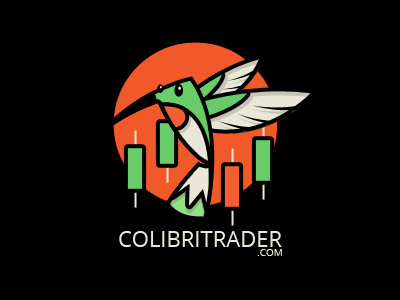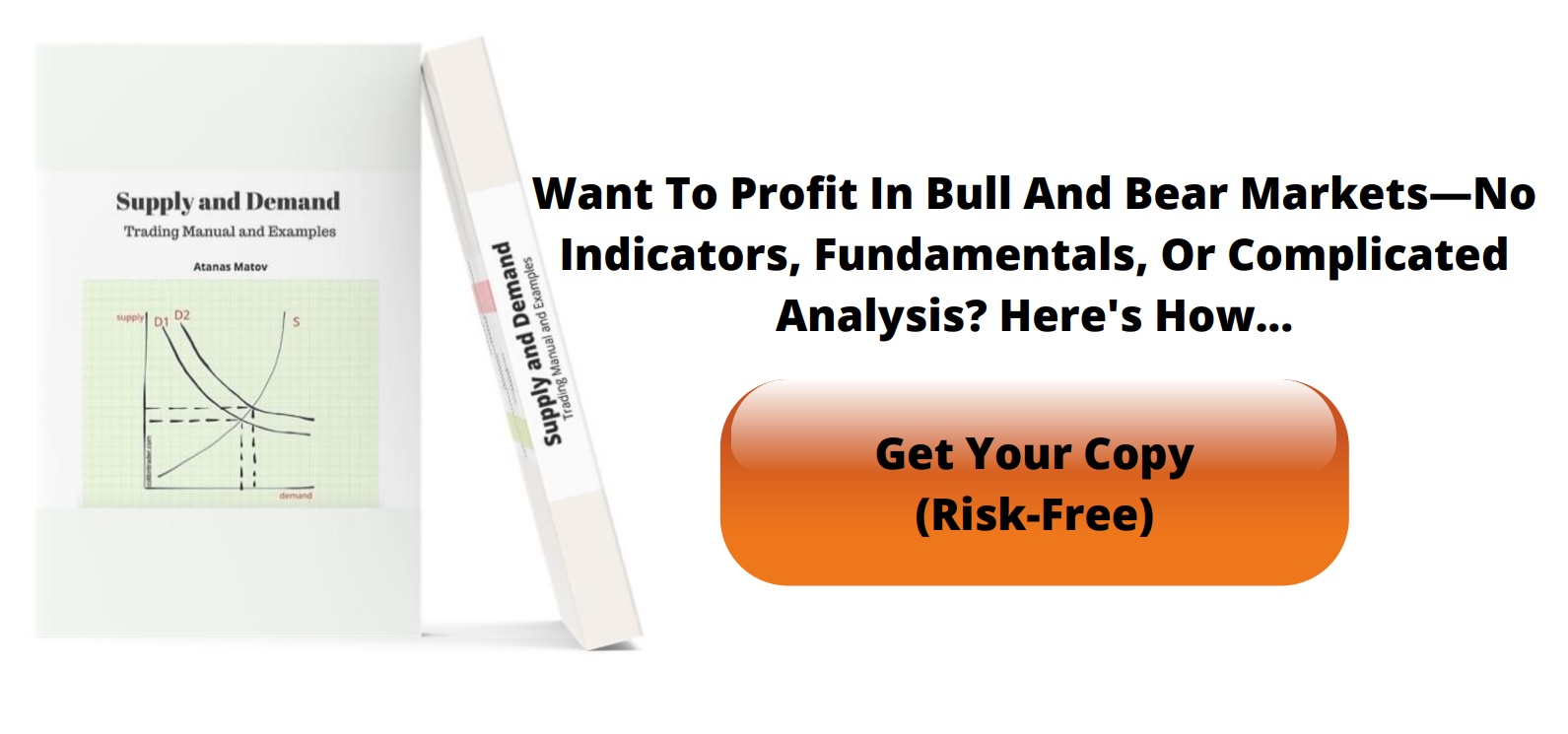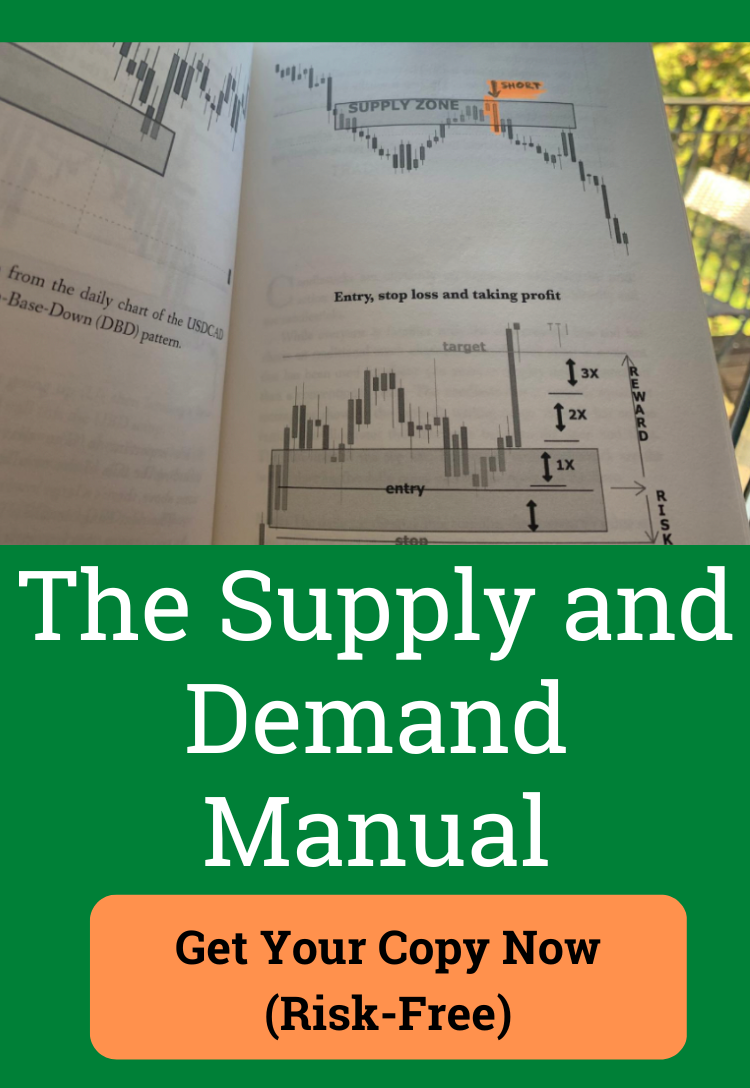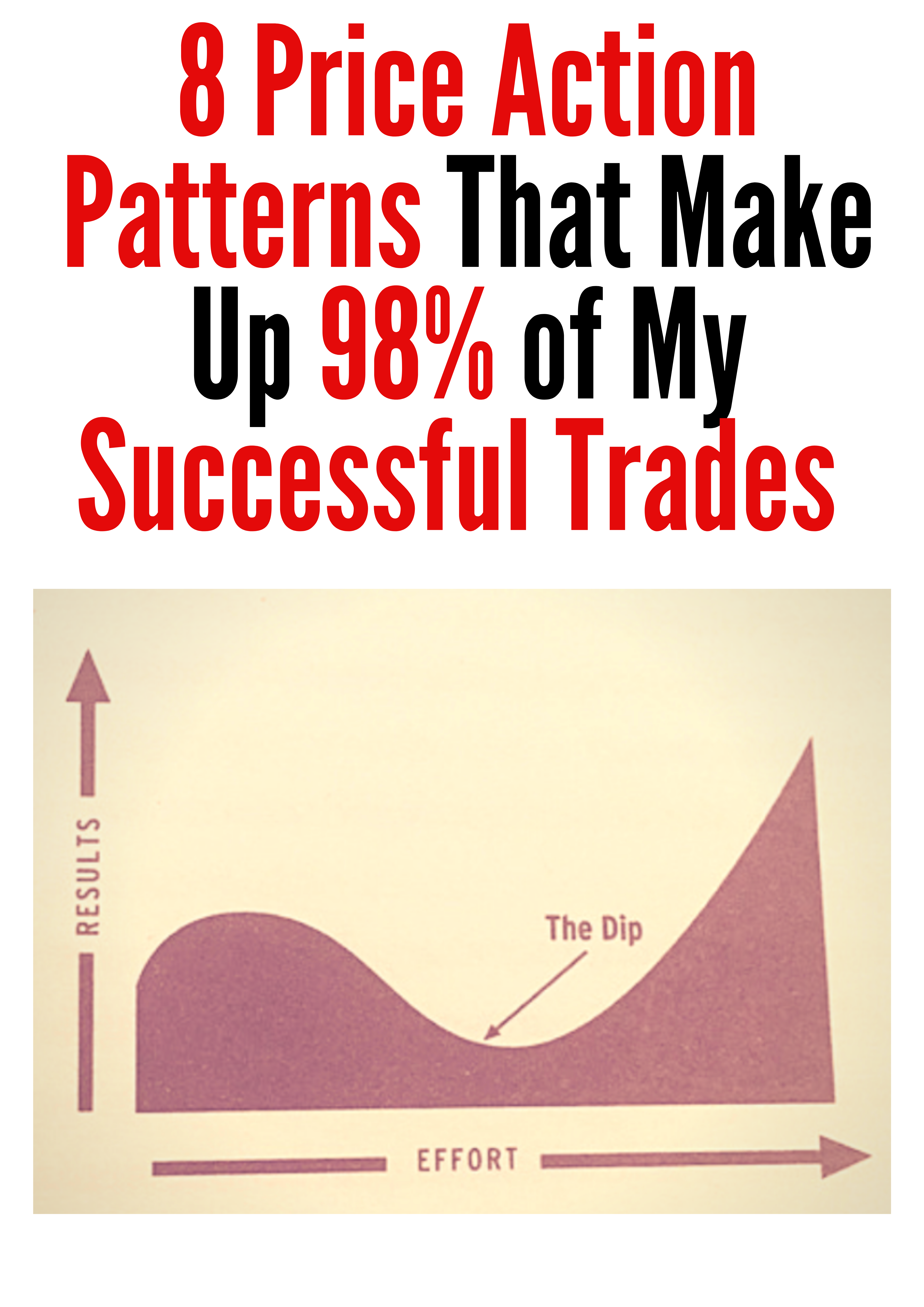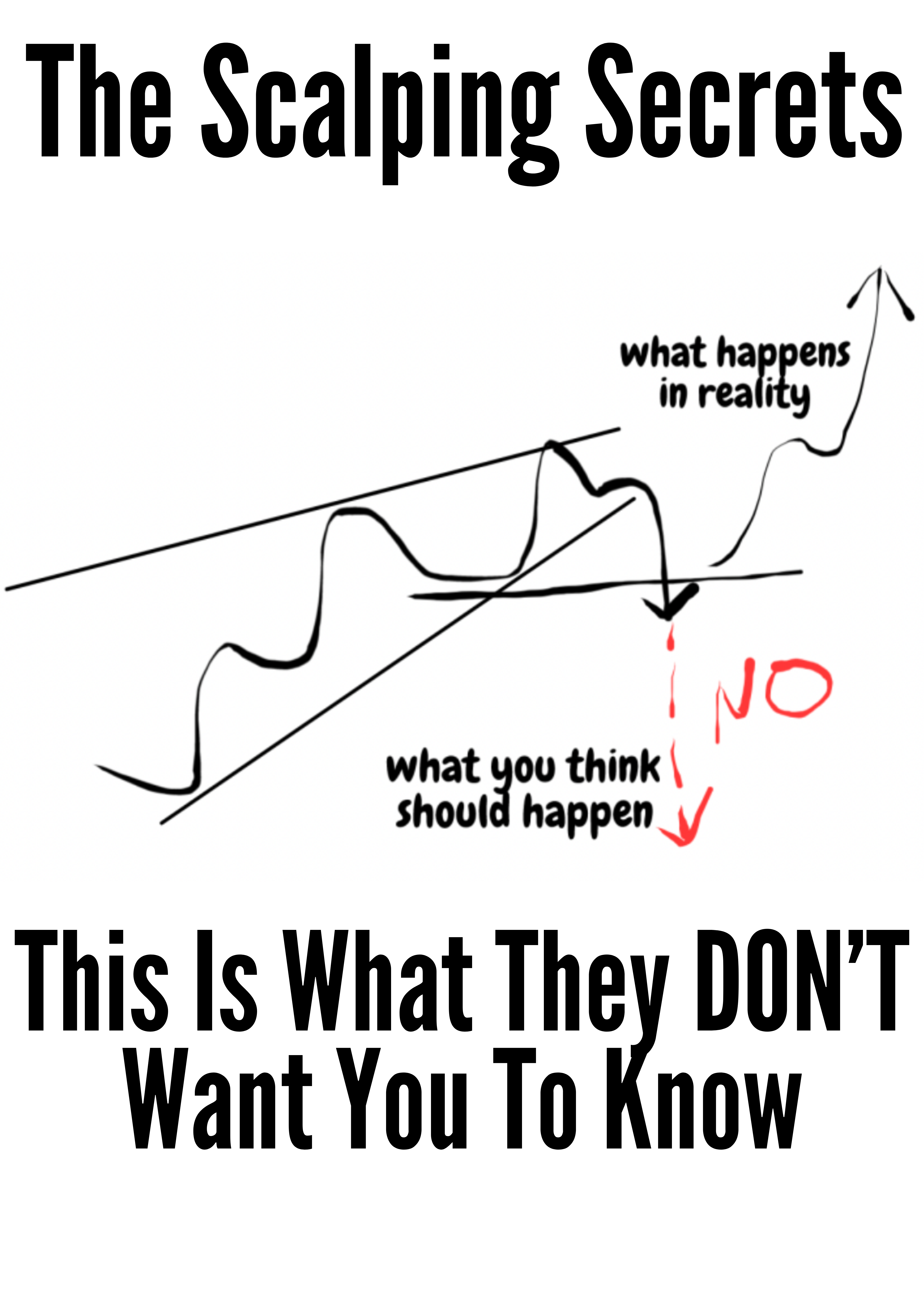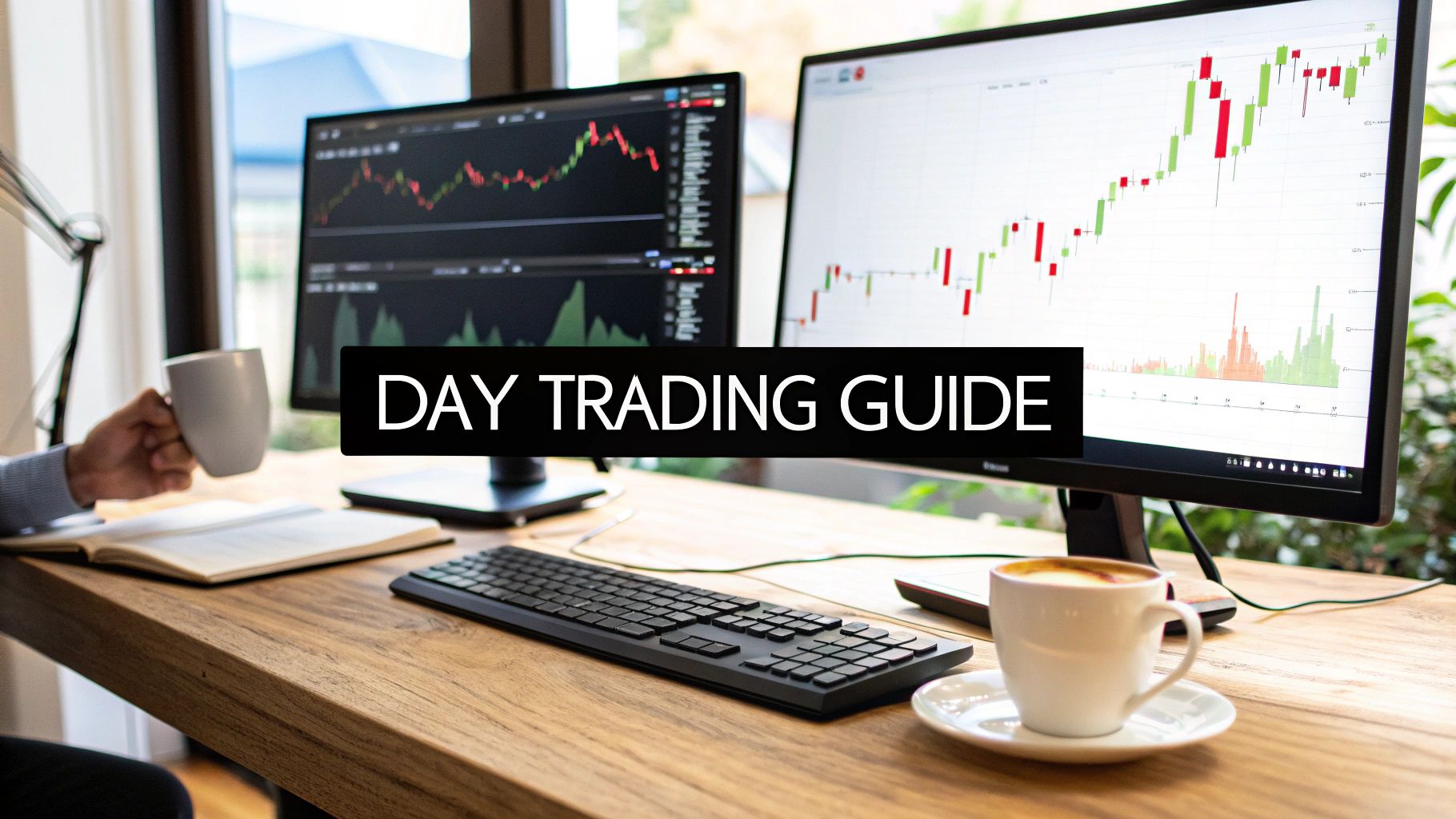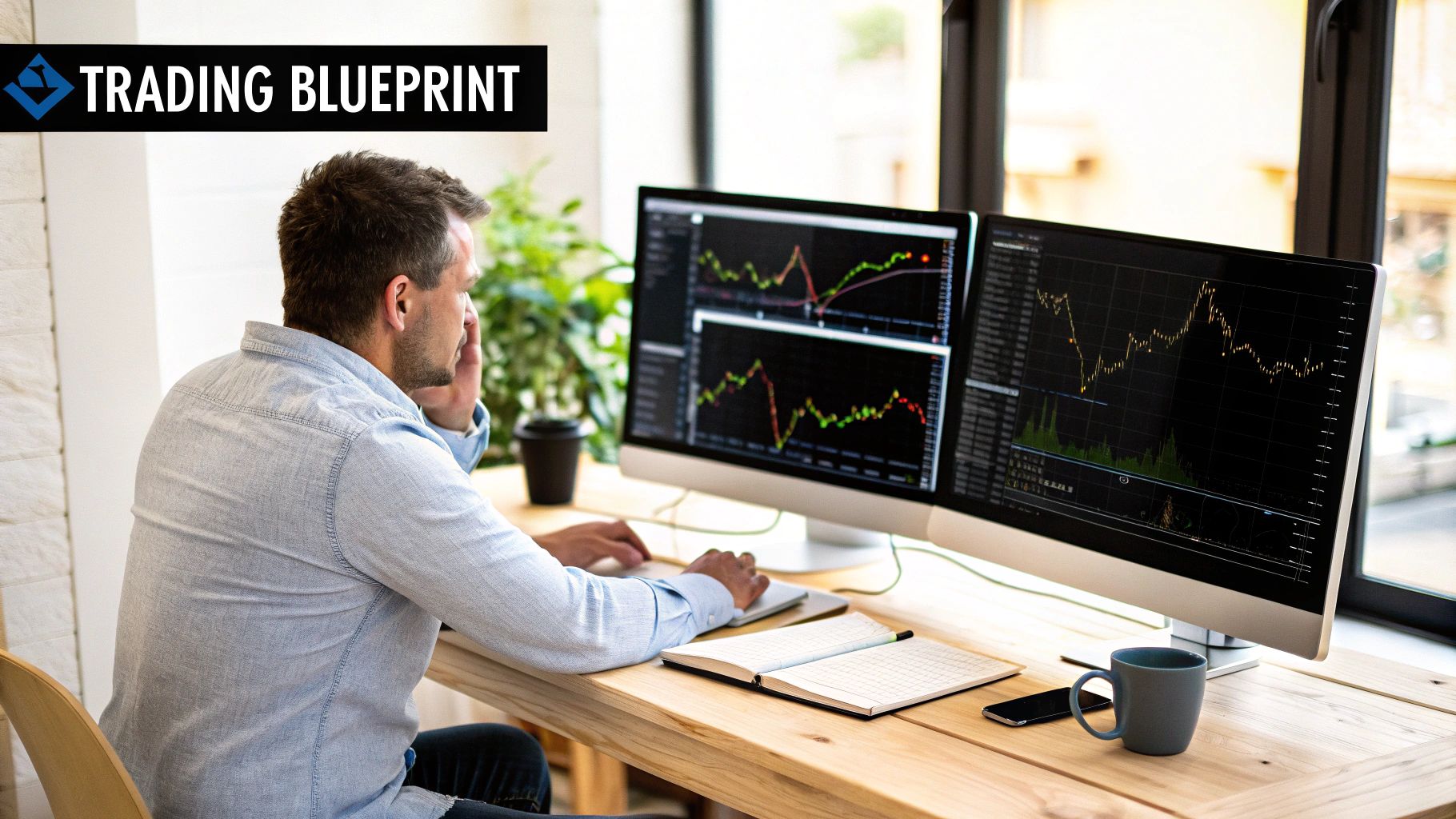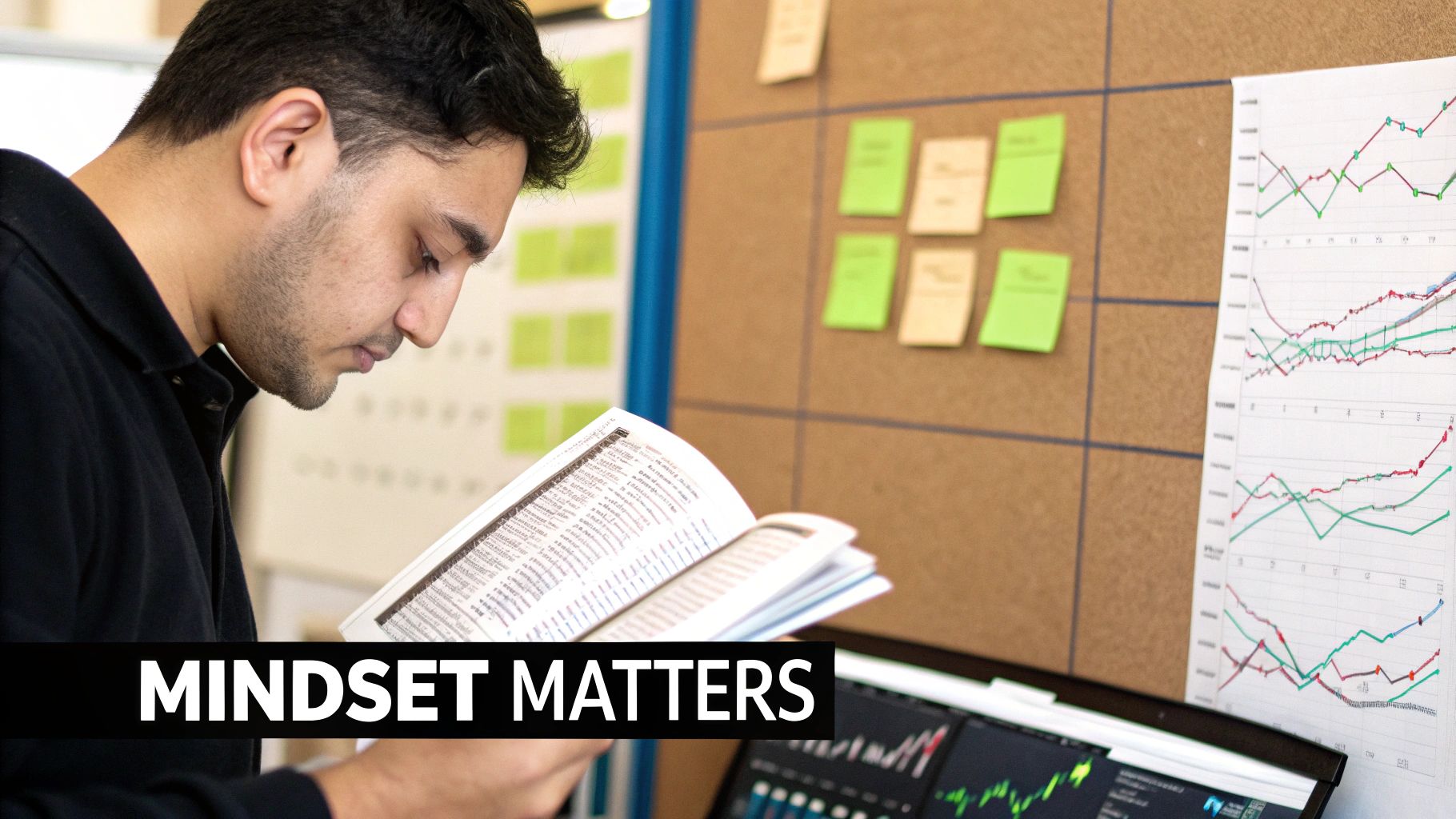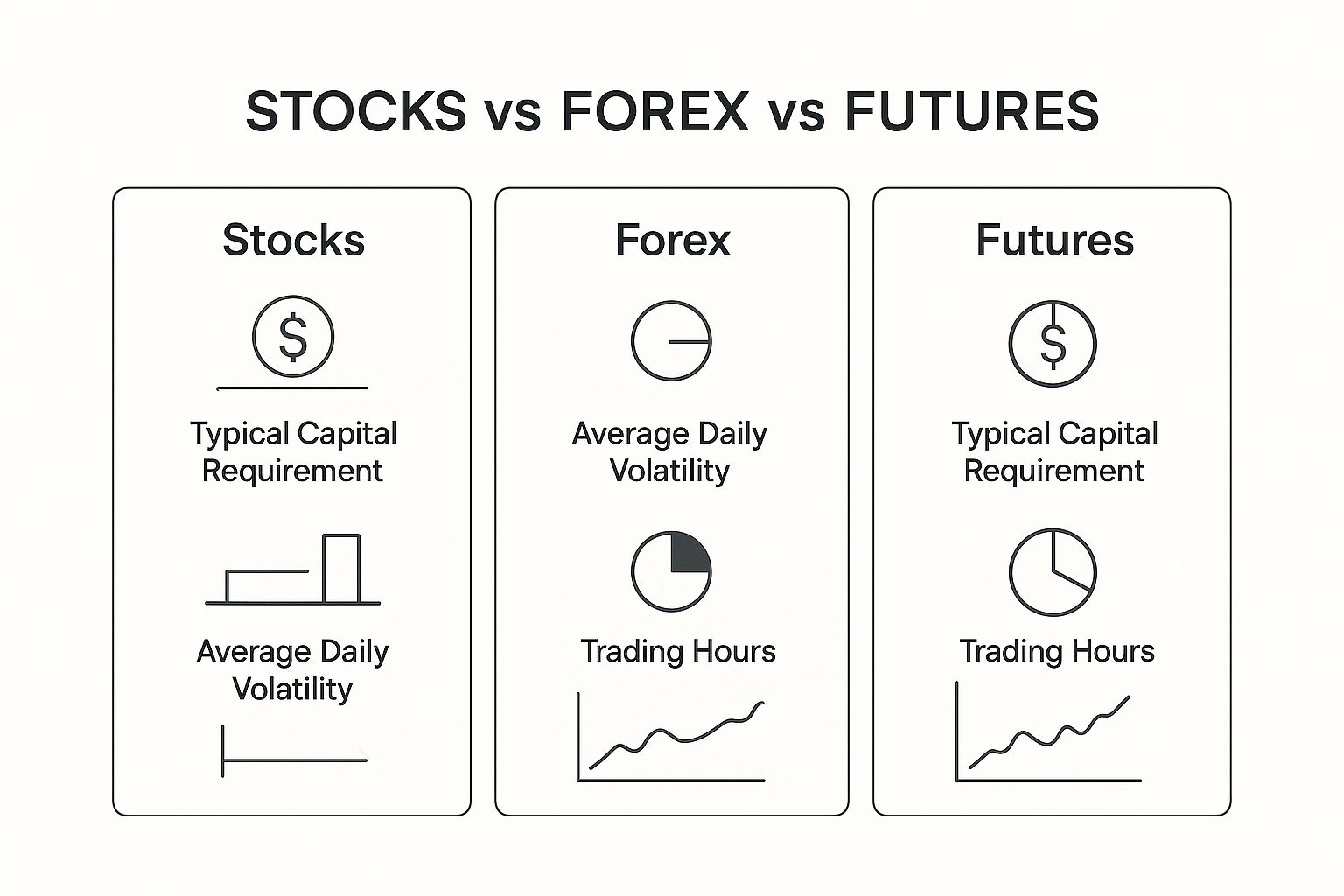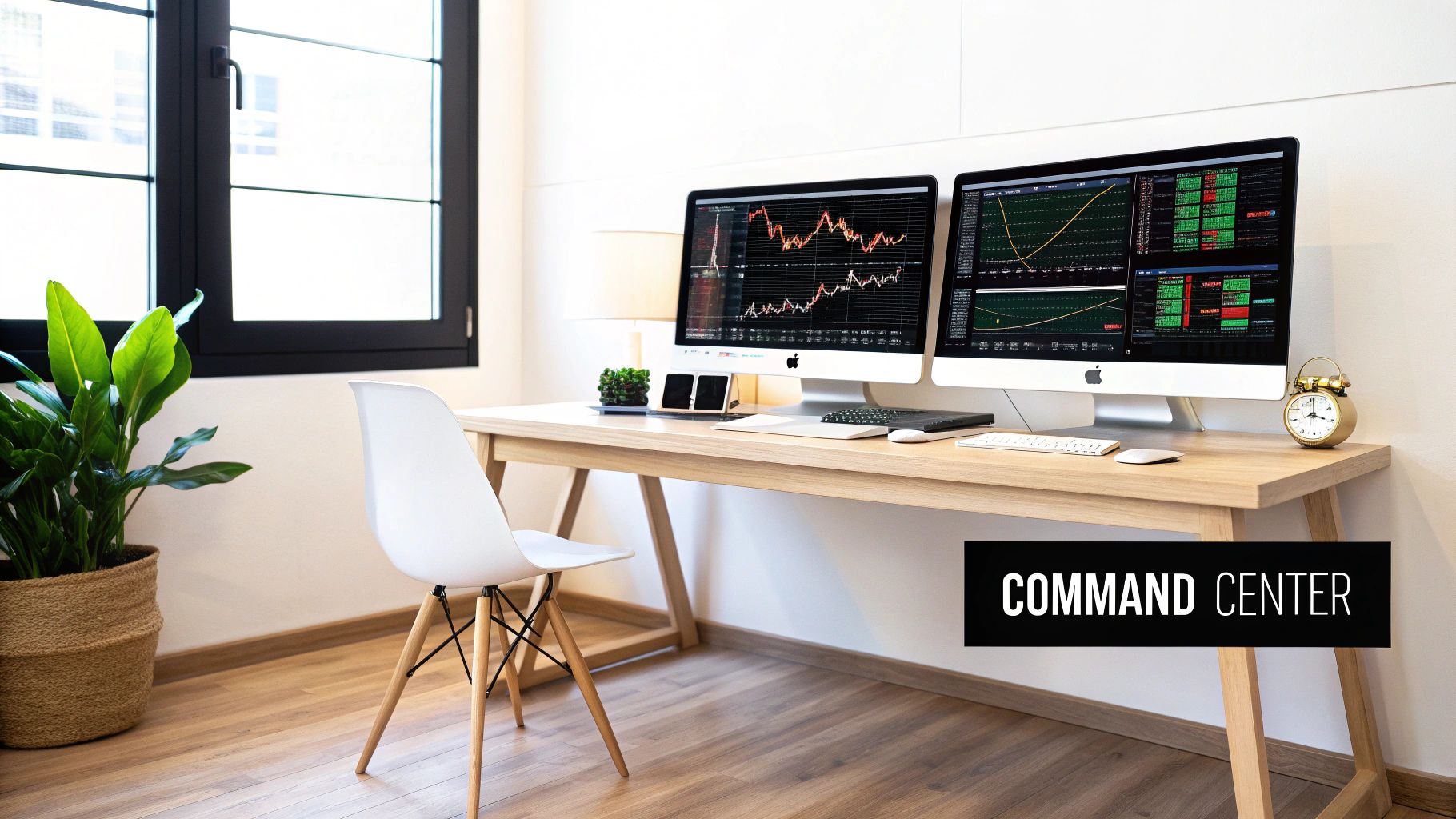How to Become a Day Trader From Home in 2024
So, you're thinking about day trading from home. It's an appealing idea, no doubt—being your own boss, managing your own time, and tapping into the markets from your living room. But before you jump in, let's get real about what it takes. This isn't a hobby or a side hustle you can just dabble in.
Treating it like a business from day one is the only way to have a shot. That means having a solid plan built on capital, education, technology, and most importantly, discipline. You're the CEO, the analyst, and the risk manager all rolled into one.
Your Day Trading From Home Blueprint
Forget the flashy images of fast money and an easy lifestyle. The reality of day trading is far more demanding. Success doesn't come from some secret indicator or a "can't-lose" signal service. It's built on a professional framework, brick by brick.
This journey requires a clear-eyed view of the steep learning curve ahead and the mental toughness needed to handle losses. Before you even think about risking a single dollar, you have to understand the core pillars that hold up a sustainable trading career. This blueprint is designed to cut through the noise and set honest expectations from the start.
The Four Pillars of a Trading Business
To build a trading career that can actually last, you need four key pillars firmly in place. If you neglect even one, your entire structure becomes unstable—like a table with a wobbly leg.
- Sufficient Risk Capital: This is the money you can genuinely afford to lose. It's not your rent money or your grocery budget. Think of it as your business's operating cash and, just as importantly, your psychological safety net.
- A Deep Educational Foundation: You have to learn the language of the market. This goes way beyond memorizing a few chart patterns. It's about truly understanding market mechanics, price action, and technical analysis.
- The Right Technology: Your tools are your connection to the markets. A reliable broker, professional charting software, and a fast, stable internet connection are non-negotiable.
- Unwavering Discipline: This is the big one. It's the glue that holds everything else together. It's your ability to stick to your trading plan, manage your emotions when things get heated, and take a loss without spiraling.
Let's look at these pillars in a more structured way. Think of this table as the foundational checklist for your new business.
Core Requirements for a Home Day Trading Business
| Pillar | Description | Why It's Essential |
|---|---|---|
| Risk Capital | Funds dedicated solely to trading that you can afford to lose. | Protects your personal finances and reduces emotional decision-making driven by fear of loss. |
| Education | In-depth knowledge of market dynamics, strategies, and analysis. | You can't compete in the markets without understanding how they work and how to find an edge. |
| Technology | Reliable hardware, fast internet, and professional-grade software/broker. | Your tools are your lifeline. Slow execution or system crashes can be incredibly costly. |
| Discipline | The psychological ability to follow your rules consistently, especially under pressure. | This prevents impulsive trades, revenge trading, and other emotional errors that wipe out accounts. |
Each pillar supports the others. Without proper education, your capital is just gambling money. Without discipline, the best strategy in the world is useless.
The path to becoming a day trader from home is a tough one, and the numbers don't lie. Research shows that around 40% of traders quit within the first month, and only a mere 13% are still in the game after three years. You can get the full breakdown of these sobering day trading statistics to understand the landscape you're entering.
This high failure rate isn't meant to scare you off, but to ground you in reality. The appeal is strong, especially with remote work becoming the norm, but success is reserved for those who treat it with the seriousness it deserves.
"The market is a device for transferring money from the impatient to the patient." Your entire blueprint must be designed to build patience and enforce discipline above everything else.
Consider this guide your first step in building that solid business foundation. By approaching day trading with a professional mindset and a clear plan, you can begin to navigate the markets with purpose instead of just hope.
Building Your Trader's Mindset and Knowledge Base
Before you even think about clicking that "buy" or "sell" button, the real work has to happen between your ears. Day trading is far more of a mental game than a technical one. Your success will be built on a solid foundation of market knowledge and, even more critically, psychological resilience.
So many aspiring traders get completely obsessed with finding the perfect, magic-bullet strategy. They spend months chasing indicators but completely neglect the very thing that has to execute that strategy—their own mind.
Trust me, even the best trading plan on earth is worthless if you haven't conditioned yourself to perform under pressure. This is about learning to control your own impulses, not just reading charts.
Mastering the Market's Language
First things first, you need to become fluent in the language of the markets. Don't worry, this isn't about memorizing complex algorithms or advanced economic theory. It’s about understanding the raw mechanics that make prices move up and down.
Before you go any further, you absolutely must have a firm grip on these concepts:
- Basic Market Mechanics: You need to know what a bid and ask price is, how order flow actually works, and what liquidity means for your ability to get in and out of a trade without getting slammed.
- Essential Order Types: Understand the difference between a market order (get me in now at any price) and a limit order (get me in only at this price or better). Mastering stop-loss orders is non-negotiable for protecting your capital.
- Foundations of Technical Analysis: At its core, this is just the study of price history to spot patterns and probabilities. Focus on the bare essentials first—support and resistance levels, trendlines, and a few simple chart patterns.
A classic rookie mistake is "analysis paralysis." New traders plaster their charts with dozens of indicators until they're too confused to make a decision. Stick to understanding pure price action first; it tells you everything you need to know about the real-time battle between buyers and sellers.
Conquering Your Inner Market
Let me be clear: the biggest obstacle you'll face in your trading journey isn't the market. It's you. The emotional rollercoaster driven by greed and fear blows up more trading accounts than any bad strategy ever could.
Greed is what makes you hold a winning trade way too long, hoping for "just a little more," only to watch it reverse and turn into a loser. Fear is what makes you cut a good trade way too early or freeze up and fail to enter a perfect setup. Taming these two beasts is your primary job.
Developing this kind of emotional discipline is an ongoing battle. To get a head start, it's incredibly helpful to explore resources that dig into https://www.colibritrader.com/the-psychology-of-trading/, which can give you a much deeper understanding of the mental hurdles you're about to face.
To truly excel, a day trader has to cultivate an almost unwavering focus. It's worth exploring strategies to enhance focus and attention for that extra edge.
Practical Steps for Building Discipline
Discipline isn't some innate trait you're born with. It's a muscle you build through consistent, deliberate practice. Here are a few real-world techniques you can use to start conditioning your mind for the realities of trading.
- Create a Physical Trading Routine: Don't just roll out of bed and stumble over to your computer. Establish a pre-market routine. Review your watchlist, check for any market-moving news, and get your head in the game. This creates a professional boundary between your personal life and your trading business.
- Define Your Rules of Engagement: Your trading plan (which we'll get to later) will have crystal-clear entry and exit rules. Your only job is to follow them. No exceptions. If a trade setup doesn't meet 100% of your criteria, you don't take it. Period.
- Practice Patience Above All: Sometimes the best trade you can make is no trade at all. Trying to force trades on slow, choppy market days is one of the fastest ways to bleed your account dry. Learn to sit on your hands and wait for the A+ setups to come to you.
Imagine you have a rule to only trade stocks that are up more than 3% on high volume. You spot one that’s up 2.8% and it looks really good. The undisciplined trader jumps in, bending the rules "just this once." The disciplined trader waits, knowing from experience that small compromises always lead to big losses.
Building this knowledge base and mental fortitude takes time and effort. It’s definitely the least glamorous part of trading, but it's the one that will ultimately decide whether you succeed or just become another statistic.
Choosing Your Market and Building a Trading Plan
Once you've started working on your trading mindset, the next piece of the puzzle is deciding where you’re going to trade and how you’re going to do it. Every market has its own personality, and your choice will directly shape your daily routine, how much capital you need, and your overall trading experience. After you've picked your arena, it's time to draft the most critical document for your business: your trading plan.
Think of your trading plan as the constitution for your entire operation. It's a concrete set of non-negotiable rules that governs every single move you make. Trading without one is like trying to find your way out of a dense forest without a map or compass. You're just wandering, guided by emotion and impulse—a proven recipe for blowing up an account.
Selecting Your Trading Arena
For most day traders working from home, the action happens in one of three main battlegrounds: stocks, foreign exchange (forex), or futures. Each has a distinct feel, and your job is to find the one that fits your capital, schedule, and tolerance for risk like a glove.
Here’s a quick rundown of the big three:
- Stocks: Trading company shares is the classic starting point for many. With thousands of stocks available, there's always something moving. The big hurdle, though, is capital. In the US, the Pattern Day Trader (PDT) rule requires you to maintain a minimum account balance of $25,000, which puts it out of reach for many beginners.
- Forex: The foreign exchange market is all about trading currency pairs like the EUR/USD. It's the biggest financial market on the planet, famous for its deep liquidity and the fact that it runs nearly 24 hours a day during the week. That flexibility is a massive advantage if you can't be glued to a screen during typical market hours.
- Futures: This market involves contracts to buy or sell something—like the S&P 500 E-mini, crude oil, or gold—at a set price on a future date. Futures are heavily leveraged, which is a double-edged sword. It means you can control a large position with a relatively small amount of capital, amplifying both your potential profits and, more importantly, your potential losses.
To help you see how these stack up, here's a look at the key differences in capital, characteristics, and who they're best suited for.
Comparing Popular Day Trading Markets
This table breaks down the three main markets to help you figure out which one aligns best with your resources and trading style.
| Market | Typical Capital Required | Key Characteristics | Best For Traders Who… |
|---|---|---|---|
| Stocks | $25,000+ (US PDT Rule) | Thousands of individual companies, high familiarity, regulated exchanges. | Have significant starting capital and prefer trading well-known company shares. |
| Forex | $500 – $5,000+ | 24/5 market, extremely high liquidity, high leverage, traded in pairs (e.g., EUR/USD). | Need flexible trading hours and can start with a smaller account. |
| Futures | $2,000 – $10,000+ | Standardized contracts, focused on indices/commodities, high leverage, centralized clearing. | Want to trade broader market indices or commodities with high leverage. |
Each market presents a clear trade-off. Stocks might feel more straightforward, but the $25,000 barrier is a major roadblock. Forex and futures offer lower entry points and more scheduling freedom but demand serious respect for the power of leverage.
The forex market, in particular, is a giant in the trading world. As of 2025, the daily global forex trading volume hit an incredible $9.6 trillion, jumping 28% from 2022. Financial hubs like London, which handles 38% of global turnover, create immense liquidity. While this creates a ton of opportunity, the combination of high volatility and leverage means discipline isn't just a good idea—it's everything.
The Anatomy of a Winning Trading Plan
Your trading plan is your ultimate defense against making stupid, emotional decisions. It absolutely must be written down, it must be specific, and you need to review it constantly. A vague plan is a worthless plan. It should be a detailed operational manual that you could hand to someone else, and they'd know exactly how to execute your strategy without asking a single question.
"A goal without a plan is just a wish." In day trading, a wish will get your account wiped out. Your trading plan turns your goal of profitability into an actionable, repeatable process.
Every solid trading plan has a few core components. If you leave any of these out, you're creating a massive vulnerability in your business. Here are the non-negotiables you must define in writing:
-
Your Trading Goals and Motivation: Start with what you want to achieve and, more importantly, why. Is this for some extra income, or are you aiming for a full-time career? Knowing your "why" will keep you grounded when you hit the inevitable rough patch.
-
Market and Timeframe Specification: Be crystal clear. State which market you'll trade (e.g., Nasdaq 100 futures) and the exact chart timeframes you’ll use for analysis and execution (e.g., 5-minute chart for entries, 1-hour chart for trend context). No ambiguity.
-
Exact Entry Criteria: This is the heart of your strategy. List the precise, objective conditions that must be met before you even think about entering a trade. For example: "I will go long only when the price breaks above the high of a bullish consolidation pattern on above-average volume."
-
Precise Exit Rules: How do you get out? Define your profit targets and your stop-loss placement ahead of time. For instance: "My initial stop-loss will be placed just below the low of the entry candle. I will take partial profits at a 2:1 risk/reward ratio."
-
Risk and Money Management Protocols: This is arguably the most important section of all. Specify your maximum risk per trade (a common rule is 1% of your account balance), your maximum number of trades per day, and your "max pain" daily loss limit (e.g., if my account is down 3% on the day, I shut it down. No exceptions.).
Putting this document together from scratch can feel like a heavy lift. To get a head start and make sure you don’t miss anything crucial, it helps to use a structured framework.
For some excellent practical guidance, check out this comprehensive trading plan template that walks you through every necessary component. It takes the guesswork out of the process and helps you create a professional document that will become the bedrock of your trading career.
Designing Your Home Trading Command Center
Let's be clear: your trading environment has a direct impact on your P&L. Building out a dedicated, efficient command center isn't about looking the part; it's a professional necessity. This is your cockpit, and when real money is on the line, every tool and piece of data needs to be exactly where it should be to support quick, clear-headed decisions.
Think about it. A slow execution or a system crash can flip a winning trade into a devastating loss in a heartbeat. That's why your first job is to build a rock-solid technological foundation you can trust completely, even when the market is going haywire.
The Technological Trinity
Your entire trading operation rests on three pillars. If one of them is weak, the whole structure can come crumbling down.
- A Reliable Broker: You need a broker known for fast, stable execution and competitive commissions. Many serious day traders lean towards direct-access brokers for their speed and superior order routing. Your platform has to work, period.
- High-Speed Internet: A wired Ethernet connection is non-negotiable. Wi-Fi is great for browsing, but it's too prone to lag and dropouts for trading. A simple mobile hotspot as a backup is a cheap and smart insurance policy against an outage.
- Sufficient Computing Power: You don't need a supercomputer, but a modern machine is a must. Aim for a solid processor (an Intel i7 or equivalent) and at least 16GB of RAM. This is critical for running your charting software, broker platform, and other tools smoothly without any lag.
Treat your technology as a core investment, not just another expense. The cost of a single missed trade from a system failure can easily dwarf the price of upgrading your gear.
Arranging Your Physical and Digital Space
Once the tech is handled, it's time to organize your workspace—both physical and digital—for peak efficiency. The goal is to see everything you need at a glance without being buried under a mountain of information.
This is where a multi-monitor setup becomes a game-changer for most traders. It lets you dedicate screens to specific tasks, which kills the need to constantly alt-tab between windows.
- Monitor 1 (Primary): This is for your main charting and execution platform. Your eyes will be glued here 90% of the time.
- Monitor 2 (Secondary): Use this for keeping tabs on your watchlist, broad market indices like the S&P 500, or a real-time news feed.
- Monitor 3 (Optional): A great spot for your trading journal, performance analytics, or a chatroom with your trading community.
Beyond the screens, don't neglect your own well-being. A comfortable setup is crucial for staying focused. Spend some time mastering work-from-home ergonomics; fatigue and discomfort are the enemies of disciplined trading.
Optimizing Your Digital Workflow
A clean digital workspace is just as vital as a tidy desk. It’s all about creating a seamless flow of information that helps you execute your plan without friction.
Actionable Workflow Tips:
- Configure Your Charting Software: Never just use the default layout. Set up your charts with the exact indicators and drawing tools your strategy requires. Then, save it as a template so it loads perfectly every single time.
- Master Your Hotkeys: Every decent trading platform lets you map hotkeys to critical actions—"buy at ask," "sell at bid," "flatten position." Learning and using these can shave precious seconds off your execution, which makes a world of difference in fast markets.
- Eliminate Distractions: Your trading rig is for one thing: trading. Turn off all non-essential notifications from email, social media, and news apps. A distraction-free zone is a non-negotiable part of becoming a successful trader from home.
If you're looking for more ideas, checking out different examples of a well-designed https://www.colibritrader.com/home-trading-setup/ can give you some great inspiration. Ultimately, your command center needs to be a personalized space that reinforces discipline and supports the flawless execution of your strategy.
Transitioning from Paper Trading to Live Markets
This is it. This is the moment where theory crashes headfirst into reality.
After all the books, videos, and late-night studying, making the switch from a trading simulator to risking your own hard-earned money is the single biggest test any new day trader will face. The bridge between those two worlds is paper trading, and getting across it in one piece demands a cold, methodical approach—not a blind rush to get in on the action.
Think of your demo account as a risk-free laboratory. It's the proving ground where you take your freshly written trading plan and stress-test it in a live market environment without putting a single dollar on the line. The goal isn't to rack up a million hypothetical dollars; it’s to prove to yourself that you can follow your rules with relentless, boring consistency.
Proving Your Edge in the Simulator
Your time in the simulator is all about two things: building rock-solid habits and collecting hard data. Every single trade you place must follow your plan to the letter, as if your life savings were on the line. This is where you hammer out the kinks in your strategy and build the muscle memory needed for flawless execution when the pressure is on.
Before you even think about funding a live account, you need to hit a series of concrete, objective milestones. This isn’t about a gut feeling of being "ready." It’s about having indisputable proof that your process actually works.
Your Pre-Live Trading Checklist:
- Execute a Minimum Number of Trades: Your target is at least 100-200 trades using your primary strategy. Anything less is just noise; you need a statistically relevant sample size to know if you have an edge.
- Achieve Consistent Profitability: You must show a positive expectancy over that sample size. This is the simple math that proves your average winning trades are bigger than your average losing trades.
- Flawless Rule Adherence: Can you execute 20 consecutive trades without breaking a single rule? That means no fudging your entry criteria, no moving your stop-loss, and no violating your risk parameters.
- Log and Review Every Single Trade: Keep a meticulous trading journal. For every trade, record the setup, your reasons for the entry and exit, and a screenshot of the chart. Poring over this data is how you find your weaknesses and fix them.
Don't treat paper trading like a video game. The number one mistake new traders make is taking wild, unrealistic risks they'd never dream of taking with real money. If you do that, you learn absolutely nothing and build dangerous habits that will obliterate your live account later.
The Psychological Shift to Real Money
Once you've proven your system in the simulator, it’s time for the real deal. But be prepared—the psychological shock is immense.
A $100 loss that felt like nothing in a demo account can feel like a punch to the gut when it’s real cash. This is the arena where the emotional demons of fear and greed finally come out to play, and they don't play fair.
The secret to surviving this transition is to start incredibly, almost painfully, small. Your objective for the first few months of live trading is not to make money. Let me repeat that: your only goal is to learn how to manage your emotions and execute your plan under real psychological fire.
You are stepping into a massive global arena. The sheer scale of these markets, more accessible today than ever before, presents endless opportunities. For context, the New York Stock Exchange (NYSE) saw an average daily trading volume of roughly 1.36 billion shares in September 2025. When you add in other markets like the Nasdaq, which can see daily volumes over 9 billion shares, the liquidity is staggering. Take a moment to review some global stock market statistics to truly grasp the environment you’re about to enter.
Navigating Your First Live Trades
Your initial jump into live markets should be governed by an even stricter set of rules designed to protect two things: your capital and your confidence. This is all about survival and learning, not getting rich quick.
Rules for Your First 90 Days:
- Start with Micro Size: Trade the absolute smallest position size your broker offers. For stocks, this might be 10 shares. For futures, it’s a single micro contract. This keeps your financial losses tiny while the emotional "tuition" fee remains very, very real.
- Focus on the Process, Not the P&L: Staring at your profit and loss column will drive you insane and lead to terrible decisions. Instead, fixate entirely on your execution. Did you follow your plan perfectly on every trade? If so, that’s a successful day, regardless of the financial outcome.
- Keep Your Journal Religiously: Your trading journal is even more vital now. On top of the technical details, add a section for your emotional state. Were you anxious on entry? Did you feel euphoric after a win? This helps you connect emotional triggers to trading mistakes.
Let’s say your plan is to risk no more than $50 per trade. Your very first live trade is a winner, and suddenly you feel like a genius. The temptation to immediately double your size on the next trade is almost overwhelming.
Resist it. That's a classic rookie mistake. The professional trader sticks to the plan, trading the same small size for weeks or months, until they have proven they can handle the emotional rollercoaster with consistency. This methodical, disciplined approach is what builds the foundation for a long-term career as a day trader from home.
Common Questions About Day Trading From Home
Stepping into the day trading world naturally kicks up a lot of questions. It's an arena filled with hype and a fair bit of bad information, so getting straight answers is crucial before you put your time and, more importantly, your capital on the line.
Let's cut through the noise and tackle the real-world questions that every aspiring trader has. Getting a handle on these practicalities from the start will help you set realistic expectations and build a much stronger foundation for the journey ahead.
How Much Money Do I Realistically Need to Start?
This is the big one, isn't it? It's usually the first thing people ask, and the answer isn't a simple number. You might see brokers advertising that you can start with just a few hundred dollars, but let's be honest—that's closer to gambling at a casino than it is to professional trading.
If you're looking to trade US stocks, you'll immediately run into the Pattern Day Trader (PDT) rule. This is a big hurdle. The rule states you must maintain a minimum account balance of $25,000 if you make four or more day trades within a five-day business period. Dip below that, and your account gets restricted. Simple as that.
Thankfully, other markets are a bit more forgiving for newcomers.
- Futures Market: You can typically get started with a reputable broker for somewhere between $2,000 to $5,000. This gives you enough capital to trade the smaller "micro" contracts, which is the perfect way to get your feet wet without taking on massive risk.
- Forex Market: The barrier to entry here can be even lower, sometimes as little as $500 to $2,000. Forex offers high leverage, which makes smaller accounts viable, but it's a double-edged sword that massively amplifies your risk.
The single most important rule is to only trade with risk capital. This is money you can afford to lose. It's money that, if it vanished tomorrow, wouldn't change your life, affect your ability to pay bills, or send you into an emotional tailspin. Having a larger starting account is less about making huge profits and more about having a buffer to manage risk properly—like risking only 1-2% of your capital per trade. This is the bedrock of long-term survival in this game.
Can I Succeed Without a Finance Degree?
Absolutely, one hundred percent yes. Your success as a day trader has nothing to do with the diploma hanging on your wall. It's about your discipline, your emotional resilience, and your unwavering ability to execute a rule-based system.
In my experience, some of the best traders I've met come from backgrounds that have zero to do with finance—engineers, programmers, professional athletes, even military personnel.
Why? Because those fields hammer home the exact skills needed to thrive in the markets.
- Analytical Thinking: The skill to see patterns and make choices based on cold, hard data, not gut feelings.
- Process-Driven Execution: The discipline to follow a plan or a checklist, step-by-step, without deviation, over and over again.
- Resilience Under Pressure: The mental toughness to take a loss, shake it off, and stick to your strategy without getting rattled.
You can learn everything you need to know about the markets through dedicated self-study, good educational programs, and countless hours staring at charts. Your commitment to mastering the craft—and mastering yourself—is infinitely more valuable than your academic history.
How Long Does It Take to Become Profitable?
There's no magic timeline here. And if anyone tells you that you can be consistently profitable in a few weeks or a few months, you should run in the other direction. They are selling you a fantasy.
The road to profitability is different for everyone. It depends on your dedication, the quality of your education, and the market conditions you're trading in.
The statistics are grim for a reason: most people who try day trading quit within the first year. It’s a brutal business that shines a spotlight on every one of your psychological weaknesses.
For those who stick it out, developing real consistency is a marathon, not a sprint. You should be prepared for two to three years of intense, focused work. That time is spent learning the theory, grinding it out in a trading simulator, and then—only then—cautiously moving to a live account with very small amounts of money.
Profitability isn't a finish line you suddenly cross. It's a milestone you reach after you've made the mistakes, paid your "market tuition," and learned to control your emotional reactions to both winning and losing. It’s the outcome of a disciplined process, not the goal itself.
At Colibri Trader, we focus on giving you that structured, price-action-based education. We help you build the disciplined process you need from day one. We cut through the noise and focus on the practical skills that lead to consistent performance. Transform your trading with our proven, no-nonsense guidance by visiting us at https://www.colibritrader.com.
